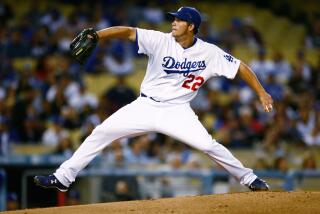Ryan still brings high Texas heat
ARLINGTON, TEXAS — Nolan Ryan had been retired for two years when he returned to the Ballpark in Arlington to take in the Texas Rangers’ 1995 home opener against the Cleveland Indians.
Sitting next to then-general manager Doug Melvin, Ryan, baseball’s all-time strikeout leader, a Hall of Fame member who threw a record seven no-hitters -- four for the Angels -- in a 27-year career, watched in horror as balls flew off the bats of the Indians.
Paul Sorrento hit a two-run home run in the second inning. Albert Belle hit a three-run shot in the third. Eddie Murray (third inning), Manny Ramirez (fifth) and Carlos Baerga (ninth) hit solo shots.
It wasn’t so much the homers that bothered Ryan. It was the reaction of the pitchers.
“I told Doug, ‘I’ve never seen a team hit five home runs off another team in my career and not one person was pushed off the plate, knocked down, or anything,’ ” Ryan said.
“These guys acted like they were throwing batting practice. They were like robots. They showed no emotion. I said, ‘That’s got to change.’ “That’s when I started thinking, if I ever get in a position to have an influence on them, that’s not tolerable.”
And so here he is, having accepted an invitation early last year from owner Tom Hicks to become team president.
Not that he needed the job.
The man who racked up 5,714 strikeouts for the New York Mets, Angels, Houston Astros and Rangers from 1966 to 1993 has a street named after him -- Nolan Ryan Expressway -- outside the park here and a statue in his honor beyond center field.
Since retiring, Ryan has owned two minor league baseball teams, a bank, a restaurant and a cattle ranch. He also worked as a special assistant for the Rangers and Astros.
“Whether it’s baseball or business,” third baseman Michael Young said, “everything Nolan touches turns to gold.”
So why would Ryan, now 62 and a grandfather of six, take on a morning-to-midnight job for a franchise that has not reached the playoffs since 1999, has not won a playoff series in 37 years and has been known for its horrendous pitching?
“Well, to spend as much time in the game as a player, I always, in back of my mind, felt like I’d like to be involved in setting the direction of an organization,” Ryan said last week, his distinctive, baritone drawl filling the press dining room.
“Owning minor league franchises and working with Houston on the player development side whet my appetite even more. When they asked me, I knew the opportunity probably wouldn’t present itself again, and the only place I’d do it is here in Texas.
“It was a unique opportunity, [wife] Ruth was agreeable to it, so I thought, why not give it a try? It’s been a big learning curve.”
First lesson: Consult Job.
“I thought I had patience, but I found out what patience really is last year,” said Ryan, who spent his first year evaluating the club. It wasn’t easy.
The team was 79-83 with a 5.37 earned-run average, the worst in baseball. Starting pitchers combined for a 52-53 record with a 5.51 ERA, 29th among 30 teams. The Rangers threw 24,986 pitches -- highest in baseball.
“There were times when I just got tired of watching it,” he said. “I was so frustrated with the pitching. We didn’t throw strikes. I think we walked in 13 or 14 runs. If you can’t throw strikes, you don’t have any business being up here.
“And I’m a believer in getting ahead in the count and staying ahead. We’d get ahead and pitch guys right back into counts. And we were pitching up too much. If your park is known for giving up home runs, you have to pitch down.”
One night the Rangers gave up a bunch of runs early amid plenty of boos.
“This guy about 10 rows behind me gets up and says, ‘Ryan, do something!’ I don’t know what he thought I could do, cancel the game or something?”
The season ended and Ryan, known for his toughness and work ethic, got down to business.
He retained General Manager Jon Daniels and Manager Ron Washington. He lured highly regarded pitching coach Mike Maddux from Milwaukee and began changing the culture.
“You can pitch here, you can pitch in Fenway Park, you can pitch in Wrigley Field when the wind is blowing out,” Ryan said.
“You can’t let the pitchers who come into your system start thinking they can’t be successful here. You have to change the mind-set.”
Ryan held mini-camps for pitchers in November and January in Arizona, featuring strength-and-conditioning and throwing programs designed to prepare pitchers for the brutal heat of Texas summers.
Pitchers threw live batting practice the first day of spring training and long-tossed more, because Ryan believes it helps build stamina. There was more sprinting, because Ryan believes it builds more explosiveness than long jogs.
He didn’t abandon pitch counts but made them more individually tailored, so those able to take on more of a workload could build durability.
“Your goal ought to be to pitch longer than that opposing starter,” Ryan said.
“If you do that, that means they went to their bullpen early because they had a problem. You increase your chances of winning right there.”
The results are indisputable. The Rangers, who open a three-game series with the Angels tonight, began Sunday with a rotation that boasts a 4.40 ERA and ranks third in the league in innings pitched, and a bullpen that has a 4.27 ERA.
Ace Kevin Millwood, on the disabled list four times in the last two years because of leg injuries, ranks third in the majors in innings pitched and is 8-5 with a 2.80 ERA. Most important: Texas is tied for first place in the American League West.
Ryan rarely visits the clubhouse -- he leaves the on-field work to the coaches -- but he’s at the park by 9:30 a.m., attends almost every home game (but few road games) and his office door is open, as reliever C.J. Wilson learned in late April.
Growing up in Fountain Valley, the hard-throwing left-hander followed the workout program from “Nolan Ryan’s Pitcher’s Bible: The Ultimate Guide to Power, Precision and Long-Term Performance.”
Said Wilson: “That’s why I have beefy legs.”
He also had a beefy 7.00 ERA in his first 10 games when he knocked on Ryan’s door.
“He was a lot more approachable than you’d think someone of his stature would be,” Wilson said. “He said even when he threw 100 mph, if he could locate his curve for strikes, that’s when he’d have his best games.
“He said if I threw my off-speed pitches for strikes more often, instead of relying so much on my fastball, I’d be more successful.”
Since then, Wilson has given up three runs in 25 innings of 25 games for a 1.08 ERA, lowering his season ERA to 2.65.
As Ryan shapes the Rangers in his image, the basics are simple. He wants pitchers to be tough, to fight through fatigue, to attack the strike zone and to pitch inside.
“There is an art to doing that,” he said. “It’s not about hitting guys or head-hunting, it’s about knowing when to pitch in and developing the ability to do it.”
Ryan tells of a conversation he had last year with Hall of Fame outfielder Tony Gwynn.
“I said, ‘Tony, who’s the toughest left-hander you had to face?’ He said Randy Johnson. I said, ‘What about Steve Carlton?’ He said, ‘Nope, I never had a problem with Carlton.’ I asked why.
“He said, ‘Randy would stand me up at least once every game we faced him, and I was aware of that, so I couldn’t look out over the plate. Carlton never did that. He pitched me away, away, away. That’s my strength, and I never had to worry about the inside.’
“That sums it up right there. Every pitcher should hear that and say, ‘I need to pitch inside.’ ”
--
More to Read
Go beyond the scoreboard
Get the latest on L.A.'s teams in the daily Sports Report newsletter.
You may occasionally receive promotional content from the Los Angeles Times.







